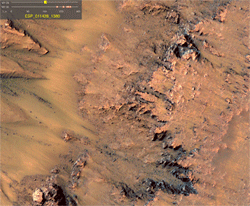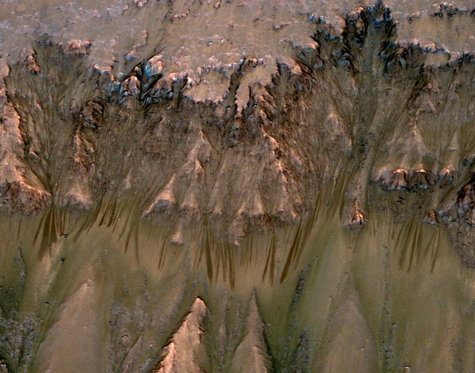Since Mariner 9 entered Martian orbit in 1971, we’ve been gathering evidence of Mars’ wet history. Early on, satellite mapping revealed ancient land forms carved by water; more recently, data from the Phoenix Lander, Mars Reconnaissance Orbiter, Mars Odyssey and Mars Express have shown us conclusively that large amounts of water ice are locked away at the poles and under the Martian regolith, sometimes quite close to the surface. Because of the extremely low atmospheric pressure, the prospects of finding liquid water on modern-day Mars haven’t been good. But observations made by a team at the University of Arizona have sparked fresh hope that Mars might be wetter than we’d thought.
While the three Martian rovers and various other landers have done great work to help us better understand the planet’s geology and climate, they’ve been limited as to what terrain they can land on, and once they’re on the surface they can observe only a relatively tiny area. As such, many discoveries have been made from orbit, using instruments such as the cameras and spectrometer aboard the Mars Reconnaissance Orbiter.
Images from the MRO’s HiRISE (High Resolution Imaging Science Experiment) camera were the catalyst for a long-term investigation into possible liquid water on the Martian surface. A Nepali undergraduate named Lujendra Ojha—one of the students working in professor Alfred S. McEwen’s planetary science laboratory—was the first to notice a strange phenomenon on steep south-facing slopes. One of the HiRISE camera’s tasks is photographing terrain from two different angles, creating a “stereo pair” that allows scientists to measure surface topography. Ojha was comparing the images in one such pair, which had been taken two months apart, when he noticed a detail that was present in one but not the other: narrow, dark lines that extended downhill from rocky areas.

The team investigated further, and found that these lines occurred on many similar slopes during the Martian summer, growing slowly over a period of weeks or months before fading again when the weather turned cold. They had no topography—in other words, they were level with the surrounding regolith—and were spotted only during the summer, making surface change driven by frozen carbon dioxide an unlikely explanation. When more focused observations during the next southern summer confirmed this was a common and recurring phenomenon, McEwen’s team went ahead and published their findings, but even then they hesitated to say with certainty what the lines were, referring to them as “recurring slope lineae” (“lineae” being a generic term for dark lines on a planet’s surface—they were serious about not making any assumptions!)
The temperature on the surface of Mars can get as high as 27° C during the summer, more than warm enough to melt water ice. And while pure water would immediately evaporate—or even boil—in the thin Martian atmosphere, it’s possible that water melting through Mars’ salty regolith could result in a brine that’s much more stable. A brine that’s eutectic—meaning it freezes at a much lower temperature than normal—is also more resistant to evaporation, and would be able to remain liquid on the Martian surface for much longer than pure water, possibly giving it time to create the dark flows that McEwen and his team have been observing.
If you follow such developments, you may recall there have been several instances of Martian water almost-discovery in the last few years. In 2000, the Mars Global surveyor found a large number of gullies that resembled water-formed analogs on Earth, but they were later discovered to have been formed by the freezing and sublimation of carbon dioxide dry ice. In 2009, when photos taken just after the arrival of the Phoenix Lander revealed small blobs clinging to its struts, there was some debate as to whether they were drops of briny liquid water or clumps of frost. Given that the circumstances under which they were observed—specifically, right after the landing of a 350 kg machine—reveal very little about the possibility of naturally occurring liquid water on Mars, the excitement surrounding the maybe-droplets is telling.
After three years of investigation, McEwen is cautiously confident that his recurring slope lineae were formed by flowing water, but at the moment his team still lacks the tools to verify their hypothesis. The MRO is equipped with a spectrometer that can detect water from orbit, but the RSL are too small for it to read. At the Study of Applications of Large Space Optics (SALSO) workshop that took place this past winter, McEwen presented a spacecraft proposal that he’s developed with Lockheed Martin: the Mars Orbiting Space Telescope. MOST would tackle numerous science and technology goals—including an optical communications test, like the one about to launch aboard LADEE—but chief among them would be achieving much finer grain observations of the Martian surface. These instruments would allow McEwen to more definitively answer the question of liquid water on Mars, but even if NASA decides to go forward with MOST, its launch would still be several years away. (For comparison: the LADEE satellite has been in development since 2007, and won’t launch until later this spring.)
In the meantime, the volume of data-rich images being taken of Mars is still incredible. In researching this article I plunged head-first into a resource I didn’t even realize existed: the enormous archive of HiRISE images, which you can browse by science themes like Polar Geology, Future Exploration/Landing Sites, Climate Change and Seasonal Processes. You can also see some of the stereo pairs I mentioned earlier. The website is a little clunky, but you can unearth some real gems with a little bit of poking around.
~~~
Side Note: If you’re curious as to why the prospect of liquid water on Mars is so exciting, NASA put together a short and easy to read fact sheet describing the ways in which water is so conducive to life. It’s from the Phoenix mission, but the information is all still perfectly relevant!
~~~
Sources and Further Reading
Article by McEwen in the May 2013 issue of Scientific American (preview only, full issue is $6)
Animated GIFs of Martian seasonal flows @ HiRISE
Photos of Warm Seasonal Flows on Mars @ NASA
Why is liquid water important to life? @ NASA
Mars Reconnaissance Orbiter @ NASA
Eutectic Brines Expected in the Martian Subsurface @ Lunar and Planetary Institute
Martian Brine Info Poster @ Lunar and Planetary Institute
Mars Orbiting Space Telescope proposal @ NASA SALSO
Workshop agenda, with list of other presentations @ NASA SALSO
Phoenix Lander Spots Liquid on Mars? @ Scientific American
HiRISE image archive and resources
Alison Wilgus spends most of her time making comics and the rest of it thinking about space. Recently she’s written a SF novella about Mars and drawn an interactive webcomic about a cat, firmly planting her flags at either end of the nerd spectrum.










